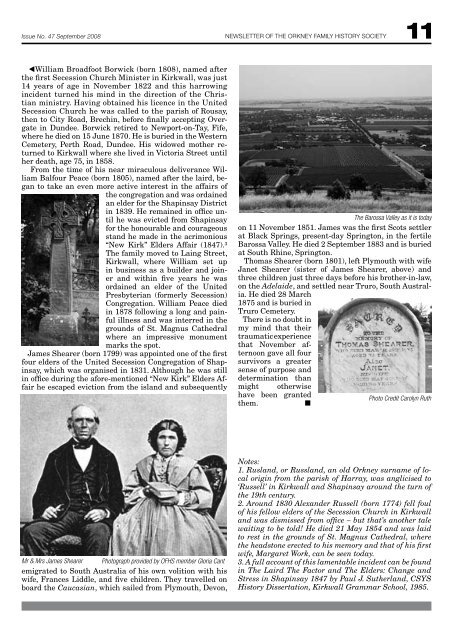SIB FOLK NEWS - Orkney Family History Society
SIB FOLK NEWS - Orkney Family History Society
SIB FOLK NEWS - Orkney Family History Society
You also want an ePaper? Increase the reach of your titles
YUMPU automatically turns print PDFs into web optimized ePapers that Google loves.
Issue No. 47 September 2008 <strong>NEWS</strong>LETTER OF THE ORKNEY FAMILY HISTORY SOCIETY 11<br />
FWilliam Broadfoot Borwick (born 1808), named after<br />
the first Secession Church Minister in Kirkwall, was just<br />
14 years of age in November 1822 and this harrowing<br />
incident turned his mind in the direction of the Christian<br />
ministry. Having obtained his licence in the United<br />
Secession Church he was called to the parish of Rousay,<br />
then to City Road, Brechin, before finally accepting Overgate<br />
in Dundee. Borwick retired to Newport-on-Tay, Fife,<br />
where he died on 15 June 1870. He is buried in the Western<br />
Cemetery, Perth Road, Dundee. His widowed mother returned<br />
to Kirkwall where she lived in Victoria Street until<br />
her death, age 75, in 1858.<br />
From the time of his near miraculous deliverance William<br />
Balfour Peace (born 1805), named after the laird, began<br />
to take an even more active interest in the affairs of<br />
the congregation and was ordained<br />
an elder for the Shapinsay District<br />
in 1839. He remained in office until<br />
he was evicted from Shapinsay<br />
for the honourable and courageous<br />
stand he made in the acrimonious<br />
“New Kirk” Elders Affair (1847).³<br />
The family moved to Laing Street,<br />
Kirkwall, where William set up<br />
in business as a builder and joiner<br />
and within five years he was<br />
ordained an elder of the United<br />
Presbyterian (formerly Secession)<br />
Congregation. William Peace died<br />
in 1878 following a long and painful<br />
illness and was interred in the<br />
grounds of St. Magnus Cathedral<br />
where an impressive monument<br />
marks the spot.<br />
James Shearer (born 1799) was appointed one of the first<br />
four elders of the United Secession Congregation of Shapinsay,<br />
which was organised in 1831. Although he was still<br />
in office during the afore-mentioned “New Kirk” Elders Affair<br />
he escaped eviction from the island and subsequently<br />
Mr & Mrs James Shearer Photograph provided by OFHS member Gloria Cant<br />
emigrated to South Australia of his own volition with his<br />
wife, Frances Liddle, and five children. They travelled on<br />
board the Caucasian, which sailed from Plymouth, Devon,<br />
The Barossa Valley as it is today<br />
on 11 November 1851. James was the first Scots settler<br />
at Black Springs, present-day Springton, in the fertile<br />
Barossa Valley. He died 2 September 1883 and is buried<br />
at South Rhine, Springton.<br />
Thomas Shearer (born 1801), left Plymouth with wife<br />
Janet Shearer (sister of James Shearer, above) and<br />
three children just three days before his brother-in-law,<br />
on the Adelaide, and settled near Truro, South Australia.<br />
He died 28 March<br />
1875 and is buried in<br />
Truro Cemetery.<br />
There is no doubt in<br />
my mind that their<br />
traumatic experience<br />
that November afternoon<br />
gave all four<br />
survivors a greater<br />
sense of purpose and<br />
determination than<br />
might otherwise<br />
have been granted<br />
Photo Credit Carolyn Ruth<br />
them. L<br />
Notes:<br />
1. Rusland, or Russland, an old <strong>Orkney</strong> surname of local<br />
origin from the parish of Harray, was anglicised to<br />
‘Russell’ in Kirkwall and Shapinsay around the turn of<br />
the 19th century.<br />
2. Around 1830 Alexander Russell (born 1774) fell foul<br />
of his fellow elders of the Secession Church in Kirkwall<br />
and was dismissed from office – but that’s another tale<br />
waiting to be told! He died 21 May 1854 and was laid<br />
to rest in the grounds of St. Magnus Cathedral, where<br />
the headstone erected to his memory and that of his first<br />
wife, Margaret Work, can be seen today.<br />
3. A full account of this lamentable incident can be found<br />
in The Laird The Factor and The Elders: Change and<br />
Stress in Shapinsay 1847 by Paul J. Sutherland, CSYS<br />
<strong>History</strong> Dissertation, Kirkwall Grammar School, 1985.



